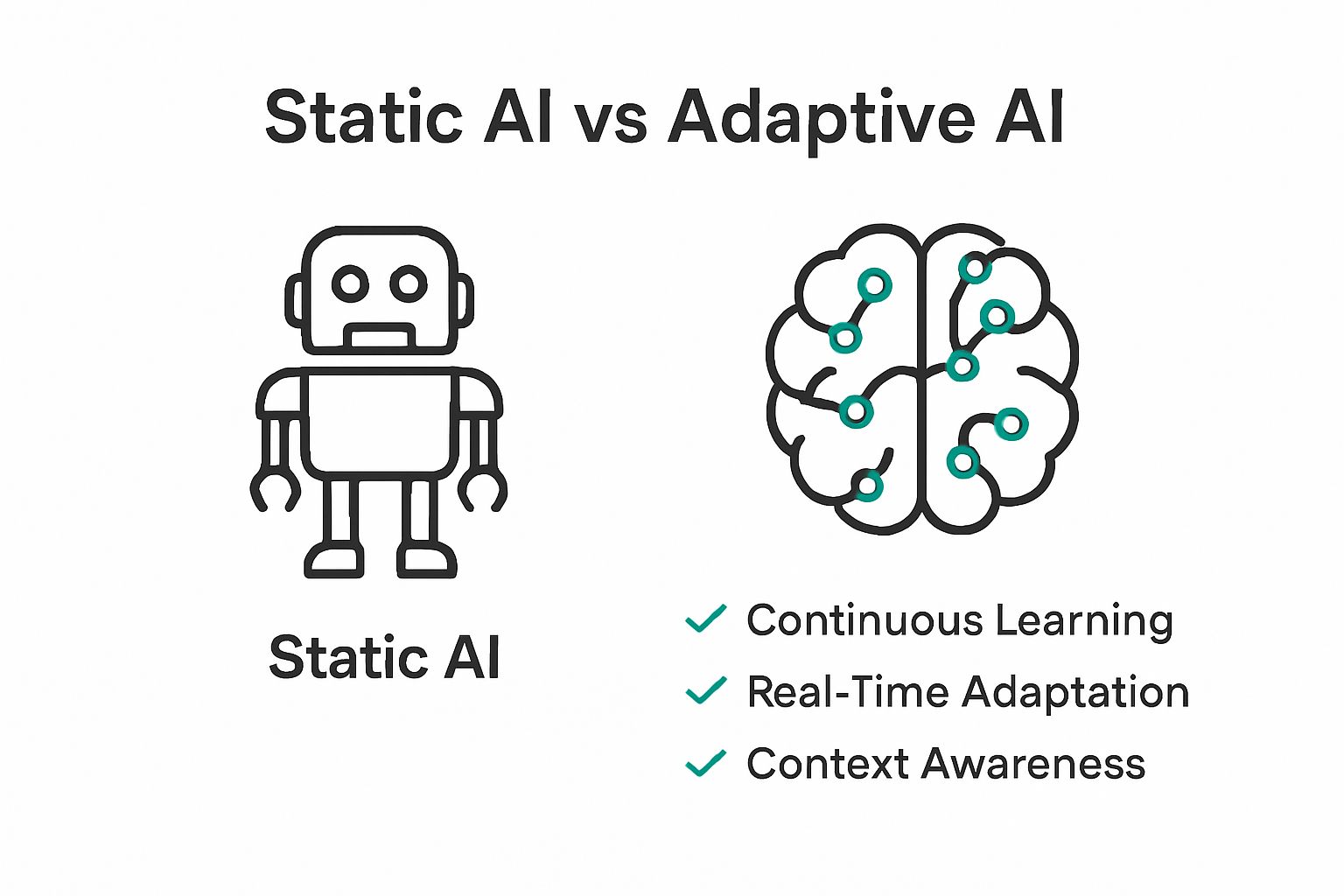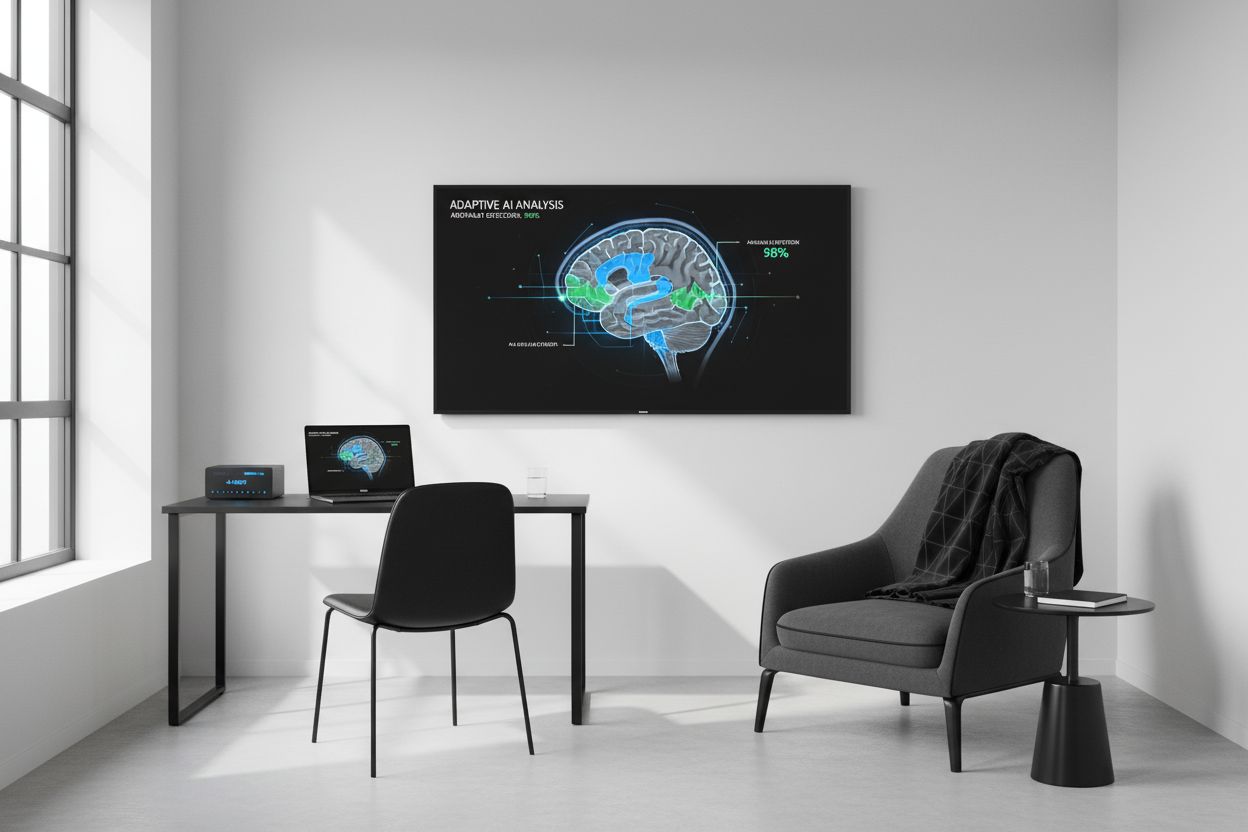What is Adaptive AI? Understanding Its Importance and Function

Adaptive AI is shaking up how businesses and technology leaders think about smarter machines. Some companies are seeing up to a 40 percent jump in operational efficiency by using adaptive AI, according to McKinsey. Most people assume AI is all about rigid rules and fixed algorithms. In reality, the biggest breakthroughs are happening because these systems can now change their decisions on the fly, learning from every single outcome without anyone having to step in.
Table of Contents
- Defining Adaptive AI: Fundamental Concepts
- Why Adaptive AI Matters for Businesses
- How Adaptive AI Works: The Mechanisms Behind It
- Key Concepts of Adaptive AI Explained
- Real-World Applications of Adaptive AI
Quick Summary
| Takeaway | Explanation |
|---|---|
| Adaptive AI dynamically learns from environments | It autonomously adjusts algorithms and decision-making processes based on real-time data inputs. |
| It enhances business resilience and agility | Organizations gain strategic advantages by adapting proactively to emerging market changes. |
| Adaptive AI improves operational efficiency | Companies can streamline workflows and reduce errors through continuous performance analysis. |
| Proactive trend anticipation is key | Businesses can use adaptive AI to predict market shifts and allocate resources effectively. |
| Applications span multiple industries | From healthcare to business, adaptive AI transforms how systems operate by learning in real time. |
Defining Adaptive AI: Fundamental Concepts
Adaptive AI represents a transformative approach to artificial intelligence that fundamentally reimagines how machines learn and respond to complex environments. Gartner defines adaptive AI as an advanced system capable of dynamically adjusting its own learning and behavior based on real-world changes, moving far beyond traditional static AI models.
The Core Mechanics of Adaptive Intelligence
At its essence, adaptive AI operates through sophisticated feedback mechanisms that enable continuous learning and self-modification. Unlike conventional AI systems that require manual retraining, these intelligent systems can autonomously recalibrate their algorithms, decision-making processes, and predictive models in response to new data inputs.
The fundamental architecture of adaptive AI includes several critical components:
- Dynamic Learning Algorithms: Capable of recognizing patterns and adjusting computational strategies without explicit human intervention
- Real-Time Feedback Loops: Mechanisms that continuously evaluate system performance and trigger immediate algorithmic adjustments
- Context-Aware Processing: Ability to understand and interpret environmental changes with remarkable precision
Practical Implications for Business
For business leaders, adaptive AI represents more than a technological advancement it is a strategic tool for building resilient, responsive organizational capabilities. Learn more about AI integration strategies that can transform how companies approach complex decision-making and operational challenges.
By embracing adaptive AI, organizations can create systems that not only react to changes but anticipate and proactively navigate emerging business landscapes. This approach enables businesses to develop more intelligent, flexible solutions that can rapidly evolve alongside increasingly complex market dynamics.
Why Adaptive AI Matters for Businesses
In an increasingly volatile business landscape, adaptive AI emerges as a critical technological strategy that enables organizations to remain agile, competitive, and responsive to rapid market changes. McKinsey research highlights that businesses leveraging adaptive AI can potentially increase their operational efficiency by up to 40% while simultaneously reducing risk and improving strategic decision making.
Strategic Competitive Advantage
Adaptive AI provides businesses with a unique opportunity to transform traditional reactive approaches into proactive, intelligent systems. By continuously learning and adjusting, these AI models can identify emerging trends, predict potential challenges, and recommend strategic interventions before they become critical issues. This predictive capability allows businesses to:
- Anticipate Market Shifts: Detect subtle changes in consumer behavior and market dynamics
- Optimize Resource Allocation: Dynamically redistribute resources based on real-time performance insights
- Enhance Risk Management: Quickly identify and mitigate potential operational risks
Operational Resilience and Efficiency
Beyond strategic advantages, adaptive AI drives significant operational improvements. Explore AI integration strategies that can help transform your business processes. These intelligent systems can autonomously streamline workflows, reduce human error, and create more efficient operational models by continuously analyzing performance data and suggesting improvements.
The true power of adaptive AI lies in its ability to learn from both success and failure, creating increasingly sophisticated problem-solving capabilities that evolve alongside your business. By embracing this technology, organizations can build more intelligent, flexible infrastructures that are not just responsive, but genuinely anticipatory.
How Adaptive AI Works: The Mechanisms Behind It
Adaptive AI represents a sophisticated technological framework that goes beyond traditional machine learning models by incorporating dynamic, self-evolving mechanisms. IBM research reveals that these systems fundamentally differ from static AI by continuously recalibrating their algorithmic approaches based on emerging data and environmental contexts.
Machine Learning and Continuous Adaptation
The core of adaptive AI lies in its advanced machine learning architectures that enable real-time learning and autonomous adjustment. These systems utilize complex neural networks and probabilistic models that can instantaneously analyze incoming data, recognize emerging patterns, and modify their computational strategies without requiring explicit human reprogramming.
Key technological components that drive adaptive AI include:
- Neural Plasticity Algorithms: Capable of restructuring computational pathways based on new information
- Contextual Learning Mechanisms: Systems that understand and interpret nuanced environmental signals
- Probabilistic Decision Frameworks: Models that can assess multiple potential outcomes simultaneously
Feedback Loops and Intelligent Recalibration
Discover how AI transforms decision making through intelligent, adaptive technologies. The most critical aspect of adaptive AI is its sophisticated feedback loop system, which allows continuous performance evaluation and immediate algorithmic refinement.
Unlike traditional AI models that require manual retraining, these intelligent systems can autonomously detect performance variations, understand the root causes of potential errors, and proactively implement corrective strategies.
This self-improving capability means that adaptive AI systems become progressively more intelligent and precise over time, transforming from reactive tools into proactive, predictive technologies that can anticipate challenges and generate innovative solutions across complex business environments.
Key Concepts of Adaptive AI Explained
Adaptive AI represents a groundbreaking approach to artificial intelligence that transcends traditional computational models by embedding intelligence with dynamic learning capabilities. Gartner research emphasizes that these systems fundamentally reimagine how machines process, learn, and respond to complex environments.
Core Architectural Principles
The foundational architecture of adaptive AI is built upon sophisticated mechanisms that enable continuous learning and autonomous decision making. Unlike traditional AI systems that operate within predefined parameters, adaptive AI models can dynamically reconfigure their internal structures, algorithms, and processing strategies based on real-time data inputs and environmental context.

The critical architectural components include:
- Self Optimization Frameworks: Systems capable of autonomously improving their performance metrics
- Dynamic Inference Engines: Computational models that can rapidly adjust predictive algorithms
- Contextual Reasoning Modules: Intelligent subsystems that understand and interpret nuanced environmental signals
Intelligent Adaptation Mechanisms
Learn more about human collaboration in AI systems to understand how adaptive intelligence truly functions. These advanced systems employ sophisticated machine learning techniques that go beyond traditional pattern recognition. They can understand complex relationships, anticipate potential challenges, and proactively generate solutions by continuously analyzing multiple data streams and learning from each interaction.
The transformative power of adaptive AI lies in its ability to create intelligent systems that are not just reactive, but genuinely anticipatory. By integrating advanced probabilistic models, neural network architectures, and real-time feedback mechanisms, these technologies represent a quantum leap in computational intelligence that can dynamically evolve and improve without constant human intervention.
Real-World Applications of Adaptive AI
Adaptive AI is transforming multiple industries by providing intelligent, responsive solutions that can dynamically adjust to complex challenges. Smithsonian Magazine research highlights how these technologies are revolutionizing sectors ranging from healthcare to education by creating systems that learn and evolve in real time.
Healthcare and Medical Diagnostics
In medical environments, adaptive AI demonstrates extraordinary potential for improving patient outcomes and clinical decision making. These intelligent systems can analyze vast medical datasets, recognize subtle patterns in patient records, and generate predictive insights that human practitioners might overlook. By continuously learning from new medical research, patient interactions, and treatment outcomes, adaptive AI can help healthcare professionals make more accurate diagnoses and develop personalized treatment strategies.

Key applications in healthcare include:
- Personalized Treatment Planning: Generating individualized medical recommendations based on complex patient data
- Early Disease Detection: Identifying potential health risks before symptoms become apparent
- Medical Image Analysis: Rapidly interpreting complex medical imaging with unprecedented accuracy
Business and Operational Intelligence
Explore AI-driven tasks for business success to understand how adaptive technologies can transform organizational capabilities. In the business landscape, adaptive AI enables companies to develop more resilient, responsive operational strategies. These systems can monitor market trends, predict consumer behavior, optimize supply chains, and dynamically adjust business processes in response to emerging challenges.
By integrating adaptive AI, organizations can create more intelligent infrastructure that anticipates changes, mitigates risks, and generates innovative solutions across complex and rapidly evolving business environments. The true power of these technologies lies in their ability to transform from reactive tools into proactive, strategic assets that drive continuous improvement and competitive advantage.
This table outlines the main real-world application areas of adaptive AI, summarizing how these advanced systems deliver specific benefits across different industries.
| Industry | Application Area | Adaptive AI Benefits |
|---|---|---|
| Healthcare | Medical Diagnostics | Improves diagnostic accuracy and supports personalized treatment planning |
| Healthcare | Early Disease Detection | Identifies risks before symptoms emerge |
| Healthcare | Medical Image Analysis | Interprets complex imaging data rapidly and accurately |
| Business | Operational Intelligence | Optimizes supply chains, monitors trends, adapts to new challenges |
| Business | Consumer Behavior Prediction | Anticipates market shifts for better strategic planning |
| Business | Risk Management | Quickly detects and mitigates potential risks |
| Business | Resource Optimization | Dynamically allocates resources based on real-time data |
Empower Your Business With Adaptive AI Solutions
Is your organization struggling to keep up with constant market changes and complexity? The article has shown how adaptive AI enables real-time learning, smarter decision making, and operational resilience. If you are facing challenges with static systems that cannot evolve or need help turning AI from theory into tangible results, you are not alone. Business leaders like you want solutions that are practical, trustworthy, and directly aligned with core goals. That is where our expertise comes in—helping you move from uncertainty to confidence through proven AI strategies built for leaders.

Ready to turn the promise of adaptive AI into real competitive advantage? Partner with the team at Average Robot to unlock tailored AI strategies designed for long-term value. Discover practical ways to improve efficiency, increase agility, and make data-driven decisions that future-proof your business. Start by learning more about how AI can future-proof your business today or explore essential AI integration strategies for leaders. Take the next step now so your organization leads rather than lags behind. Connect with us for personalized guidance and a partnership you can trust.
Frequently Asked Questions
What is adaptive AI?
Adaptive AI is an advanced form of artificial intelligence that can dynamically adjust its learning and behavior based on real-world changes, allowing for continuous learning and self-modification without manual retraining.
How does adaptive AI differ from traditional AI systems?
Unlike traditional AI systems that operate within predefined parameters and require manual updates, adaptive AI can autonomously recalibrate its algorithms and decision-making processes in real time based on new data inputs and environmental contexts.
What are the benefits of implementing adaptive AI in businesses?
Implementing adaptive AI can increase operational efficiency by up to 40%, enhance risk management, improve strategic decision-making, and create systems that can anticipate market shifts and dynamically optimize resource allocation.
The following table clarifies the key differences between adaptive AI and traditional AI systems, helping readers quickly compare how each approach functions and adds business value.
| Aspect | Adaptive AI | Traditional AI |
|---|---|---|
| Learning Approach | Continuously adapts and self-modifies in real time | Relies on fixed rules and requires manual retraining |
| Response to New Data | Automatically recalibrates algorithms with new inputs | Needs explicit updates to handle new data |
| Human Intervention | Minimal ongoing involvement after deployment | Frequent manual updates and oversight |
| Decision-Making Flexibility | Highly adaptive and context-aware | Static, often limited to predefined scenarios |
| Business Value | Enables proactive risk management and efficiency gains | Primarily reactive, offering limited business agility |
| Example Benefit | Up to 40% increase in operational efficiency | Incremental improvements with slower adaptation |
What industries can benefit from adaptive AI?
Adaptive AI has applications across various industries, including healthcare, where it can enhance medical diagnostics and personalized treatment planning, as well as in business operations, where it can optimize supply chains and improve consumer behavior predictions.




